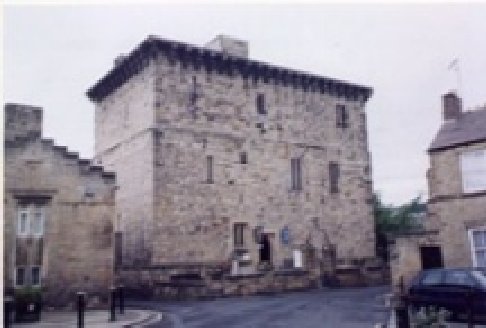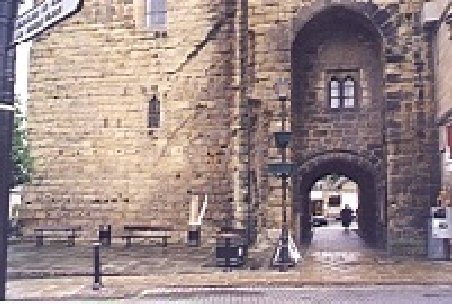
For
Hexham and district use
O.S.
Hexham is a splendid Border town with many features in the town and in the
surrounding countryside to keep the historian busy for a long time.
It was once the capital of Hexhamshire when it was independent of Northumberland until 1572. Built in the 14th century the massive gatehouse was in itself a formidable defensive system
Hexham dates back to be seven century when a monastery was known to have existed there. When the northern counties of England rebelled against the Normans Hexham was destroyed but by the 13th century had recovered to be an important market town. From the 15th century onwards Hexham was repeatedly attacked by the Scottish and much of the old town was destroyed.
In 1296 Hexham was attacked and
suffered severely with great loss of lofe and many buildings being
destroyed. The schoolhouse was torched and all thew occupants -
2oo schollboys - were killed. The very next year hexham was attacked
again by William Wallace.
Hexham Abbey
he Moot Hall and Gallery.

Market Place.
A reference library
providing material on Border life and its people.
It is housed in the restored medieval Moothall in the Market Place.
15th century building, grim, with massive walls was originally the gateway to an enclosure in which the government troops were garrisoned.
The Hall houses a variety of arts and crafts, exhibitions and a library.
Border History Museum
This is the old jailhouse of 1330, the first purpose built jail in England and is a formidable fortified tower.
It is open to the public and tells the story of reiving families and life along the Borders during the 15th and 16th centuries. The Old Jailhouse is an essential visit for all those who are
The Old Gaol is the earliest documented
purpose-built prison in England. It was built by order of the
Archbisop of York 1330-33. It held prisoners from Hexhamshire,
and in the C16th from the English Middle March, before their
trial in the nearby Moothall Court Room. The museum displays
introduce visitors to the life and times of the Border
Reivers. Collections
description
Arms and armour from the C15th and
C16th Items of local history (Tynedale) interest, photographs,
documents and objects Border Library holds the Butler
Collection, books, tapes and manuscript music relating to the
culture of the Borders
Prudhoe Castle
Haughton Castle
There has been a settlement there since Saxon times and there are many ancient spellings of the town's name including Hutoldesham, Hestoldesham, Hextoldesham and Halgutstad. One interpretation is that the names refer to the tributaries to the Tyne which run through the town.
Until 1571, Hexham was head of an ancient shire which was a regality, county palatinate and diocese. In this year, by Act of Parliament the shire was incorporated into the County of Northumberland and became an ecclesiastical peculiar of the Diocese of York. The term Hexhamshire is still used to refer to the area comprising the parishes of Hexham, Allendale and St John Lee.
The building of the Benedictine Abbey and church, was begun by Wilfrid Bishop of York in 674. After being destroyed by the Danes. It was re-founded in 1113 as a monastery for Augustinian Canons. The church of St Andrew although it has Saxon origins was also rebuilt in the 12th century.
Until the accession of James VI of Scotland to the throne of England the English border was governed by Wardens appointed to maintain law and order. The border was divided into three marches and Hexham was the headquarters of the Middle March. It also boasts the oldest purpose built gaol in the country.
Hexham's most notable industry was the manufacture of tan, leather goods particularly gloves. AB Wright in his 1823 history of Hexham gives the following statistics.
People employed in the leather trade 1111,
Raw skins dressed annually 80000
Skins of dressed leather imported annually 18000
Pairs of gloves annually made and exported 23504 dozens
The railway came to Hexham in the 1830s with the building of the Newcastle to Carlisle railway. This replaced a scheme to build a canal between the two towns.
In 1801 the population was 3427 and by 1851 this had risen by two thirds to 5321.
Today the town is a thriving community with a wide range of facilities. It is very popular with tourists and has recently been awarded almost £1 million to restore some historic buildings including Old Gaol (now a museum) and to develop the facilities.
Now in ruins the tower is still
outstanding for its impregnable position guarded as it is by he deep
valley of the River Allen and a tributary.
It can be located near the old disused railway line and is in beautiful
countryside.
Take the A69 Alston road for 16 miles.
Map reference: 87 807583
Around and about